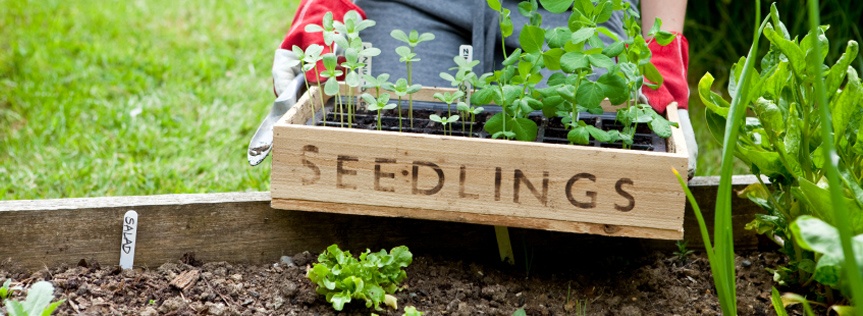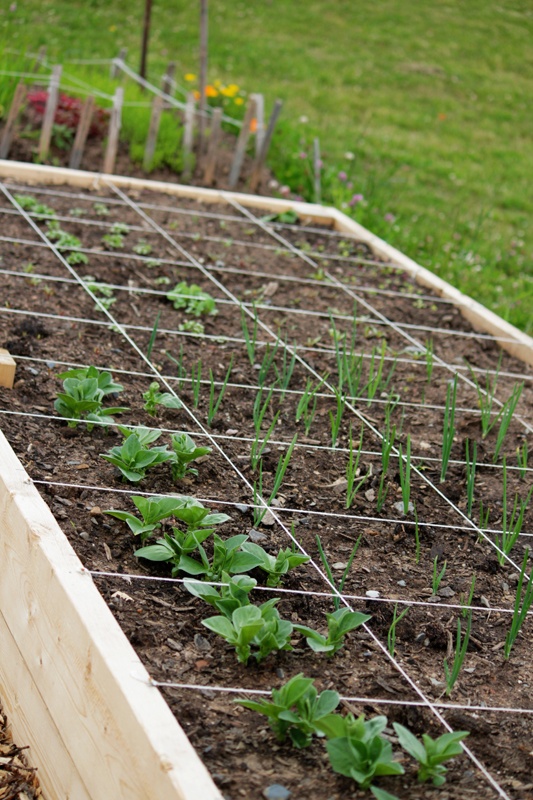Tips & Inspiration
Our library of gardening resources on topics ranging from seed starting to perennial care and beyond!
Click HereAll High Mowing Organic Seeds now 15% off, while supplies last!

1. Light requirements:
Sun Loving Plants: Nightshade Family: (Solanacea) - Peppers, Potatoes, Tomatoes, Ground Cherries, TomatillosOnion Family: (Alliacea) - Onions, Leeks, Garlic, ChivesAlso: Beans, Eggplants, Cucumbers, Squash, Zucchini
Shade Tolerant Plants: Beets, Broccoli, Cabbage, Carrots, Endives, Herbs, Kale, Lettuces, Spinach, Peas, Radish, Turnips, Swiss Chard, shrub berries (with slightly decreased yield)
What do we mean by lots of sun?
Full sun can mean anywhere from 6 hours in the afternoon, to all day. Part sun is usually morning sun, or less than 6 hours of sun in the afternoon. Sometimes it’s tricky to plant shade plants in afternoon sun, because the heat of the sun at that time can still damage leaves. If you are blessed with morning sun, you may have reduced yields from vegetables like tomatoes, but that shouldn’t discourage you from a bit of experimenting. Choosing early ripening varieties can help. Leafy greens and plants in the cabbage family actually benefit from a bit of shade to keep them cooler. They stay more tender, and do not develop as many bitter flavors.
2. Space requirements
What requires a lot of space? What doesn’t?
Vegetables with high production in small amount of space: Beans, Beets, Carrots, Lettuce, Mustard, Onions, Peppers, Radishes, Turnips. Vegetables that take up more room, but have a high yield: Summer squash (bush types), Tomatoes
Vegetables and the appropriate container size for one plant:
Root vegetables - 10-12 inch deep: Carrots, Turnips, Beets
Vigorous growers - At least 12 inches or more: Tomatoes, Cucumbers, Peppers, Squash
Shallow growers - Lettuce, Leafy greens, Radishes, 8 inch wide x 8-10 inch deep: Beans (bush), Kale, Mustard, Onions, Spinach 12 inch wide x 12 inch deep: Broccoli, Brussels Sprouts, Swiss Chard, Eggplant (Black Beauty)12 inch wide x 24 inch deep: Standard tomatoes, Bell peppers, Squash family6 inch wide x 7 inch deep - Dwarf tomatoes, Hot peppers
Space saving varieties:
Beans - French Dwarf (Purple Queen, Sprite) or any bush variety is suitable
Beets - Golden Burpees
Cabbage - Kalibos
Carrots - Rondo
Cucumbers - any bush variety will take up only 1/3 the space of regular types
Eggplant - Black Beauty, Pinstripe F1, Hansel F1
Lettuce - any variety is suitable as a space saver, wonderful for container gardening
Peas - Little Marvel, Laxton’s Progress
Peppers - California Wonder, Yum Yum and Hot Peppers
Pumpkins - Summer ball
Squash: All bush types
Tomatoes - Patio Hybrid, Tiny Tim
Many people find it easier to use vegetable transplants, as opposed to starting from seed. However, root crops should be sown directly into the soil. Legumes such as beans, peas, lentils all do better when directly sown.
3. Container Gardening 
There are many advantages to container gardening! The soil in containers warms up quickly - great for heat-loving plants like tomatoes. You can control what kind of soil gets added to your containers, and they are portable: you can move them into a sunny patch and bring them inside on cold nights. You can grow almost any variety of vegetable you want in a container, provided that container is big enough.
What containers to use: Your choice of containers is limited only by your imagination. I’ve seen discarded plastic milk crates “re-purposed” into plant containers. They drain really well and you can line up groups of them into nice, symmetrical vegetable beds- especially handy for those whose sunniest piece of property is an asphalt or gravel-covered driveway.
What soil to use: Start off with a potting soil for better drainage and water retention on hot days. Amend with compost of your choice. 2/3 potting soil to 1/3 compost. Keep in mind that compost will make your soil heavier an less able to absorb water once it has dried out.
Importance of watering: Containers are notoriously bad for drying out on hot days. Be careful to use an appropriate size of container - it’s best to use a container that is bigger than you need. You can add water retention crystals into your containers, which swell up with water for gradually release. If possible, water in the morning to deter fungi or mildews from forming and to prevent burning of foliage in the hot afternoon sun. Plants absorb more water when it is cooler. Less of the water you use evaporates.
Adding flowers for pollinators: Containers benefit from added flowers which can draw pollinator insects to help pollinate and increase yields. They also add a nice splash of colour to your garden. Some flowers are also edible, and can be added to salads or as a garnish. Some examples of great flowers to add would be marigolds calendulas, pansies/violas, chamomile (insects love it), nigella, and many more.
Aesthetic design: You don’t have to follow specific design rules, you can use your imagination in creating your urban garden. Keep in mind, some rules that have worked in the past would be repetition, groupings of threes, alternating shapes and textures, adding height for aesthetic interest, and creating multi leveled effects all unite any type of garden.
Fertilizing: Container plants need to be fed more, especially if there is no compost at all. Also, constant watering tends to leach nutrients from the soil. Some great fertilizers to try are Pink All Purpose granular fertilizer or Gaia Green Organic fertilizers
Container examples:
Salad: Growing your own salad is easy, especially in containers, which warm up more quickly than the garden. Start in late April or early May and stay tuned to the weather channel for frost warnings- you can always through a bedsheet over a patch on a cold night. Use a mixture of potting soil and compost to add to containers. Because they grow quickly, many greens are good candidates for succession planting - plant a new patch of them every couple of weeks for a fresh supply throughout the season.
Peppers: make good container candidates; the generally drier soil conditions in a pot suit the hot varieties perfectly. I’ve heard of gardeners who bring their potted pepper plants inside for the winter where they lie dormant before coming back to life the next spring.
Vertical gardening: the ultimate in space-saving! Relatively new in the gardening scene is the upside-down hanging planter. This kind of design allows you to suspend you tomato, pepper, cucumber or other fruiting plant from the side of your house, garage or tree branch. Take your transplant and feed its root ball and the bottom part of its stem up through the hole from the outside. Pack in some good-quality potting soil and there you have it - ready to hang! Don’t forget to water it.
4.Raised Bed Gardening
 There are many advantages to gardening in raised beds
There are many advantages to gardening in raised beds
Time: They can improve production and save time, space and money, as well as add a touch of beauty to the yard. You save time because you only work the soil within the beds. You do not have to till all the space between the rows and you don’t have to weed the paths, which can be mowed or mulched. Because the vegetables are planted closer together, less weeding of the garden bed is needed.
Better Crops: Crops tend to grow better in the deep, loose soil of a raised bed because it is not continually run over by you or machinery. Gardeners using the raised bed method can expect to harvest at least twice as much produce from the same number of plants.
Control Over Soil: One of the big advantages to raised bed gardening is that you have control over the soil. Even if you start with dirt that is less than desirable, you can add lots of compost that will vastly help to improve soil conditions. Loose, fertile soil tends to drain well too.
Building the Bed: Make sure you pull up all large plants, level the area, and turn over the sod or cover with a thick layer of wet newspaper before building your bed. Your bed should be 8 to 12 inches deep and the frame should be sturdy enough to hold the soil that will be placed in it. Cedar lumber is ideal because water won’t cause it to rot for many years. Another, cheaper option, is to use untreated planks of regular building lumber at least 2” thick. These will last for 2-3 years before they need to be replaced. Screw the planks of wood to 2”x2” or 4”x4” corner posts using 4 screws per board (2 at each end to attach the boards). For better stability sink the corner posts 6 inches into the ground before attaching the side boards.
Use caution in selecting materials. Used railroad ties, landscape timbers, or treated 4X4s can be laid on the ground and stacked in log cabin fashion to the desired height. Another fine option is to use old tires, large rocks, or even whole trees to create your borders. However, wood and other materials that have preservatives or industrial products on them can leach chemicals into the soil, and most people choose to avoid these materials.
Soil: Determine measurement of the bed to determine how much you need: width x length x depth = total volume. A bed that is 4 ft wide x 8 ft long and 1 ft deep = 4x8x1 = 24 cubic ft ( 1cubic yard is 27cu. ft). The mix you fill your raised bed with should be one half soil and one half compost. If the soil is dense it might help to add some sand to aid in drainage, especially if you are placing the raised bed directly on concrete. You will find that most garden soils that you can buy in bulk will have 40-60% organic material already mixed in.
Square foot Gardening in your raised bed: The square-foot gardening concept is simple: Build a raised bed, divide the space into sections of one square-foot each, and then plant vegetables (or flowers) in just the amount of space they need.
Advantages: reduced workload, less watering, easy weeding (and not much of it), and easy access to your crops. You also maximize your space usage. As the plants mature, they spread and shade the ground, making it harder for weeds to grow. Square foot gardening also allows you to get a higher yield from less growing space.
Disadvantages: The soil in intensive gardens loses its fertility much quicker. You need to amend it more regularly with organic matter and fertilizer.
Tips:
Sun Exposure: Make sure you locate the garden in an area that gets as much direct sunlight as possible. Plant tall plants in the back of a raised garden to ensure they don’t block sunlight for other plants.
Water: It helps if there is a water source close to the garden.
Spacing: Plants like turnips, carrots, herbs and lettuce use less space in your raised bed than tall or spreading crops like corn, strawberries, or pumpkins. Try growing cucumbers, tomatoes, and squash pots or containers to save space in the beds.
Fertilizers: Many people add an all purpose fertilizer to a raised bed at the beginning of every season, along with toping the bed up with organic matter.
Our library of gardening resources on topics ranging from seed starting to perennial care and beyond!
Click HereHave questions? We have answers! Send us a message and we'll be here to help every step of the way.
Click Here